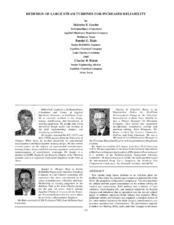| dc.description.abstract | Two similar large steam turbines in an ethylene plant are profiled. One drives the cracked gas compressor train and the other
drives the propylene refrigeration compressor. The two machines are similar and this paper concentrates on the turbine driving the cracked gas compressors. Both turbines had a history of high vibration, short bearing life, and unusual sensitivity to thermal changes and imbalance due to operation near the second critical speed. In addition, numerous blade failures had occurred. When additional turbine performance was required, a complete review of the entire turbine including the blade designs, rotordynarnics, and governor operation was commissioned. The performance upgrade included new blading, disks, seals, and other changes to the steam
path. A turning gear was added for slow-roll operation to relieve thermal effects and rotor bow. A technique was developed for mounting the turbine disks on the rotor to minimize axial disk runout and local couple imbalances. The high bearing temperatures and high vibration issues were addressed with changes in shaft and bearing designs. A submerged arc welding process increased the governor end journal diameter from 51/4 inches to 7 inches. A rotordynamic optimization analysis resulted in replacing the tilting pad bearing on the governor end with an offset-half lobed journal bearing. The tilting pad bearings on the exhaust end of the turbines were retained but redesigned for optimum performance. Interchangeability of bearings between the
two machines was maintained. These shaft and bearing changes resulted in a significant
reduction in babbitt temperature, shaft vibration, and imbalance sensitivity as well as control of the second critical speed. The
interaction of the rotor with the foundation substructure was found to be significant, and its inclusion in the analysis was required to properly design the optimized bearings. The blade design changes and steam path changes produced a more reliable design and greater than the required extra power. The addition of a turning gear drive has eliminated the thermal bow problems. A new electronic governor system has eliminated the wear
associated with the original hydraulic governor. Both turbines are now operating very smoothly at the capacity of the production facility. | en |


